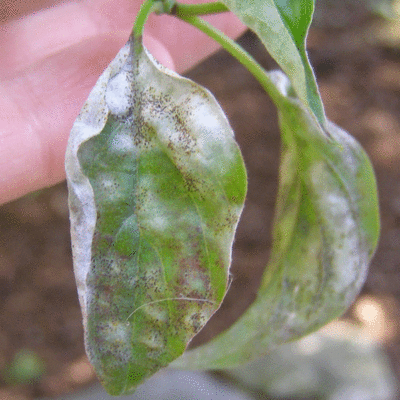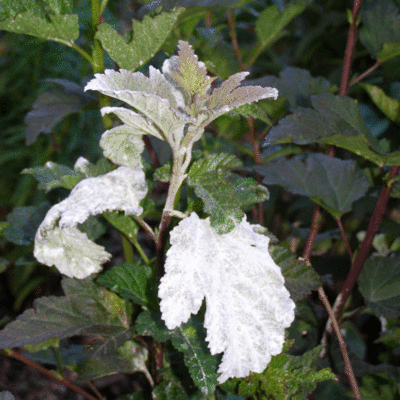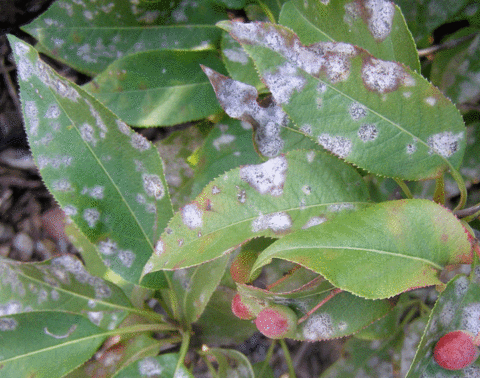Quick facts
- Powdery mildew is a common fungal disease of trees and shrubs in Minnesota.
- White to gray, powdery spots, blotches or felt-like mats form on leaves, stems and buds of infected plants.
- Disease is often most severe on young leaves and green shoots.
- Powdery mildew does not cause significant damage to the health of the tree and does not require management.
- The disease can significantly affect the look of ornamental plants like roses and purple-leaved ninebark shrubs.
- Resistant varieties, cultural control practices and fungicides can be used to manage powdery mildew.
How to identify powdery mildew
- White to gray powdery spots, blotches or felt-like mats form on leaves, green stems and buds. Infected plants may appear to be sprinkled with baby powder or covered in cobwebs.
- Young leaves, water sprouts and green shoots are often most severely affected.
- Infected leaves may be cupped or twisted at the site of the infection.
- When severely infected, leaves may turn yellow and fall prematurely during the growing season.
- In some plants, leaves turn purple to red around the infection.
- In late summer or early fall, tiny round orange to black balls form within white fungal mats.
Environmental conditions
- Powdery mildew thrives in humid conditions but does not do well if leaves are wet from frequent rain or irrigation.
- In Minnesota, powdery mildew increases in the spring and fall, when cool nighttime temperatures are followed by warm daytime temperatures.
- It can be often found throughout the growing season.
- The disease is worse on shaded plants or plant parts with little air movement such as interior or lower branches.
|
There are many species of powdery mildew fungi and they affect thousands of plant species. In Minnesota, powdery mildew has been observed on the following trees and shrubs.
- Apple
- Ash
- Azalea
- Birch
- Buckeye
- Barberry
- Cotoneaster
- Crabapple
- Catalpa
- Dogwood
- Elm
- Euonymus
- Hawthorn
- Ironwood
- Lilac
- Linden
- Maple
- Magnolia
- Oak
- Serviceberry
- Spirea
- Rhododendron
- Rose
- Viburnum
How does powdery mildew survive and spread?
- Powdery mildew fungi create dark round resting structures that contain and protect spores through the winter.
- In spring, these resting structures break open, releasing spores that are spread by the wind. These spores start new infections on succulent, new growth.
- Some species of powdery mildew fungi survive the winter in infected buds.
- In spring, the young shoots growing from infected buds are covered with velvet-like white growth of powdery mildew.
- The powdery mildew fungus grows into the plant to steal nutrients.
- Powdery spores are produced in leaf spots throughout the growing season.
- Spores spread by wind and start new infections within the plant or in neighboring plants.
- Powdery mildew needs humid conditions to start new infections.
- Spread of the disease is reduced by rain or irrigation.
- Water on the leaves prevents the light airy spores from moving on the wind.
How to manage powdery mildew
- Tolerate powdery mildew. Powdery mildew does not significantly affect the health of the tree or shrub and does not require management.
- Powdery mildew resistant varieties are available for many ornamental shrubs. Choose disease resistant varieties for new plantings or as replacement plants.
- Do not overcrowd plants. Use size at maturity as a spacing guide when planting.
- Do not fertilize infected trees and shrubs unless it is recommended by a soil test to correct a nutrient deficiency. Fertilizer will cause the tree to produce young shoots which are highly susceptible to powdery mildew.
Proper pruning
- Prune the tree or shrub during winter months to increase light penetration and improve air circulation throughout the canopy.
- During the growing season, prune only to remove severely infected shoots.
- Avoid excessive pruning of infected plants during the growing season. Pruning can cause the tree to produce new shoots which are highly susceptible to powdery mildew.
Using fungicides
Fungicides can be used to protect highly susceptible and prized ornamental shrubs like roses or ninebarks. Fungicides protect healthy green leaves and shoots from powdery mildew infection. They must be applied before disease becomes severe.
- Scout plants regularly.
- Apply fungicides when the first powdery mildew leaf spot is found.
- For shrubs with a history of disease, apply fungicides before you see disease symptoms.
- Repeat fungicide sprays according to label instructions to protect plants throughout the growing season.
Chemical treatments include:
- Thiophanate methyl
- Chlorothalonil
- Sulfur (not for sulfur sensitive plants like viburnum)
- Potassium bicarbonate
CAUTION: Mention of a pesticide or use of a pesticide label is for educational purposes only. Always follow the pesticide label directions attached to the pesticide container you are using. Be sure that the plant you wish to treat is listed on the label of the pesticide you intend to use. And observe the number of days between pesticide application and when you can harvest your crop. Remember, the label is the law.
Reviewed in 2024




